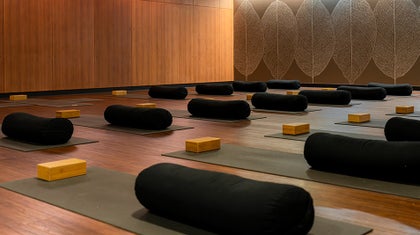3 easy breathing exercises to calm your body
by Patrick Boxall on Sunday 08 June 2025
3 min read
Three easy breathing exercises to calm your body
When stress hits, your breath is often the first thing to change. It can become shallow and rapid, leaving you with a tight sensation in your chest. But this same breath – the one that seems so impressionable – can also lead you to a state of calm.
How can breathing exercises reduce anxiety?
Breathing exercises are one of the simplest, most effective tools to calm anxiety, reduce stress and regulate your nervous system – anytime, anywhere.
When you're stressed, your body enters fight or flight mode via the sympathetic nervous system. This reaction prepares you for a threat – be it real or perceived – and is accompanied by increased muscle tension, a higher heart rate, and shallow breathing.
A study published in Brain Sciences found that 'effective breathing interventions support greater parasympathetic tone, which can counterbalance the high sympathetic activity intrinsic to stress and anxiety.'
In other words: slowing your breathing through your diaphragm switches your body from fight or flight to rest and digest. You're telling your body it's okay to relax, which in turn should lower your heart rate and blood pressure.
The benefits of diaphragmatic breathing
Not all breaths are created equal. Many people fall into the habit of taking quick, shallow breaths from their chest, increasing anxiety and reducing oxygen flow.
Diaphragmatic breathing engages the diaphragm: the large muscle at the base of your lungs. When you breathe deeply into your belly, your oxygen intake increases, your nervous system calms and your mental clarity improves.
To check your breathing style, place one hand on your chest and the other on your belly. Does your chest rise more than your belly? If so, chances are you're chest-breathing. Don't worry – with a little practice, you'll be belly breathing in no time.
Deep breathing exercises for anxiety
Below, we'll introduce you to three deep breathing exercises: box breathing, belly (or diaphragmatic) breathing, and 4-7-8 breathing. Remember to focus on breathing through your diaphragm.
Box breathing (4-4-4-4 technique)
Box breathing is a structured technique used by athletes and first responders to manage high-pressure situations. This method helps calm your mind and resets your stress response.
How to do it:
- Inhale for 4 seconds.
- Hold for 4 seconds.
- Exhale for 4 seconds.
- Hold for 4 seconds.
- Repeat for 4–5 rounds.
Belly breathing (diaphragmatic breathing)
Belly breathing brings your attention inward and slows both your breath and heart rate. This simple practice is highly effective when you need to reduce anxiety quickly.
How to do it:
- Sit or lie down comfortably.
- Place one hand on your belly, and the other on your chest.
- Inhale slowly through your nose, letting your belly rise.
- Exhale gently through your mouth, feeling your belly fall.
- Continue for 2–3 minutes.
4-7-8 breathing
The 4-7-8 method has been described by Dr Andrew Weil – the technique's developer – as 'a natural tranquiliser for the nervous system'. It's commonly used for winding down before bed or easing emotional overwhelm.
How to do it:
- Inhale through your nose for 4 seconds.
- Hold your breath for 7 seconds.
- Exhale through your mouth for 8 seconds.
- Repeat for 4 rounds.
How often should you practice breathing exercises?
Research shows that breathing practices are more likely to have greater stress-reducing benefits when performed regularly. For better effectiveness, it's recommended you practice your preferred breathing technique – be it any of the above – for at least six sessions over a week at minimum.
Ready to level up your wind down?
Rest and recovery is an important part of any wellness plan. These breathing exercises are great for calming anxiety, but you might also benefit from incorporating sauna, spa or even Sound Bath sessions into your recovery routine. Book a tour at your closest Virgin Active to learn more.
Related articles
Unwind
3 min read
Are you burnt out?
Nourish
3 min read
For wellness that lasts, ditch the trends and guilt
Move
3 min read
Yoga: the missing piece in your weekly workout routine
Enjoying our blog?
Sign up to our newsletter to get updates on training, healthy living, news and events.





